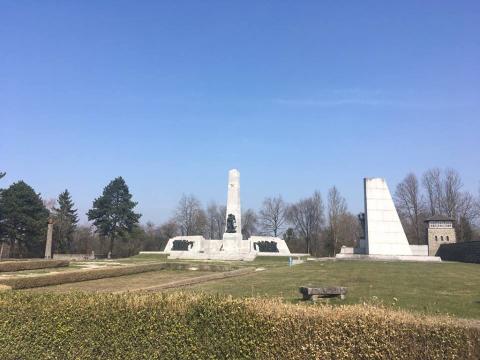It was one of the first days of Vienna; the birds gaily sang, the sky was a bright cerulean blue, and flowers were beginning to bloom. I stood on top of a cliff admiring the rolling green hills, speckled with soft-hued houses. Below me were the remnants of a marble quarry. As romantic as the setting was, the purpose of the quarry and the massive stone fortress behind me was in fact evidence of the most horrific crimes against humanity. I was at Mauthausen, a concentration camp used by the Nazis from 1938-1945.
My psychoanalytic class and other classes related to the Holocaust and memorials were at the Mauthausen for a field trip. We had left Vienna at 8 a.m. and traveled two hours to Mauthausen.
Although I had visited Holocaust memorials before, I had never seen a camp before. I was unsure of what to expect or what to feel. I did not feel ready for the intense realities. As real as the Holocaust was, it is difficult to truly comprehend. How could such an atrocity happen? How could people allow and participate in it?

We began the tour with a history presentation. I was already familiar with the major historical events, but it was interesting to hear history from a different perspective. The focuses and specific detail people use to recount history has a major impact on our understanding of the past, which influences our present attitudes and beliefs, which then predicts our behavior in the future. The presentation began with World War I with a map of the former empires and borders. The map showed how the Austro-Hungarian empire used to have a lot more territory.
And it also shows the brewing conflict with Serbia and the Austro-Hungarian empire. Serbian assassin Gavrilo Princip killed Archduke Ferdinand and World War I erupted. With war came an overwhelming sense of patriotism. Class structures were forgotten as people were engulfed with a passion for their country. This sense of patriotism was a fundamental aspect of Hitler’s campaign.
During World War I, another crucial and tragic event happened: the Armenian genocide. The Armenian genocide is considered the first genocide, at least in Europe. An earlier genocide, which was perpetrated by Germany, occurred in 1904 against the Herero and Nama in Namibia. The Armenian genocide involved Germany as well. Germany worked with the Young Turks in operating the genocide. This happened after Enver, the Ottoman minister of war, and German Kaiser Wilheim II developed a close bond. Germany helped the Young Turks develop rhetoric against Armenians of the Ottoman Empire. It is estimated that between 664,000 to 1.2 million Armenians were murdered. Genocides, systematic killings against a group of people, would, of course, be repeated in the Holocaust and the genocide of the Jews, LGTBQ+ individuals, differently-abled people, Roma, Poles, Slavic people, and Jehovah’s Witnesses.
The third historical event that shaped the Nazi’s climb to power was the Communist revolution in Russia. Kaiser Wilheim II sent Lenin to Russia in hopes that he and the Bolshevik's politically left ideologies would destabilize Russia. The plan worked very well as Soviet Russia was a disaster. People starved, and terror reigned. This taught people to mistrust leftist beliefs.
These past events culminated to the Nazi’s rise in Europe. Although some people say that the Nazis had invaded Austria, it is more likely that they were welcomed into Austria. Austrians strongly identified as Germans, so it was a small step to welcome German forces.
This leads me to Mauthausen, a concentration camp that was set up in Austria. Mauthausen imprisoned approximately 190,000 people. The people were from a wide range of nationalities and included Jews, political components, prisoners, and more.

Mauthausen looked different than what I had imagined a Holocaust camp to look like. I had imagined barbed-wire fences or wooden fences. Mauthausen was constructed with tall stone walls. Although historians are not entirely sure why they built Mauthausen that way, some theories are that the Nazis expected Mauthausen to remain for a long time and they wanted the actions to remain a secret to the public eye.
Yet, as we continued the tour, we were given a picture that showed what Mathausen used to look like. The aerial photograph included a soccer ball field. The tour guide explained to us that the SS guards whose average age was 20, liked to play soccer in their free time. They had teams and recruited SS guards from other camps to be on the team. They even invited other teams to play with them. A famous Austrian team, which exists still today, had played against them. Even worse, bodies were openly moved during the games. The people from the town saw the dead people but did not say or do anything. The atrocities of Mauthausen had been accepted as normal by that time.
We continued to go to the quarry and its infamous steps. People were forced to work tirelessly in the quarry, where the work itself was pointless. We moved on to where Jews and other prisoners were taken to be shaved and washed. Then we saw where they were forced to sleep. The room was about the same size as my dorm room, but 150 people were forced to share it in Mauthausen.
Afterward, we slowly made our way to where the gas chamber used to be. I shuddered to think of the atrocities that occurred here. I also thought of my own family. My mother's father was a Polish Jew. He and his parents had escaped but not everyone had. It was possible that they were held at Mauthausen, but when I checked the names, they were not listed.
Sure, it was a beautiful day, but that didn’t matter. I think it’s important to visit concentration camps to understand the reality of what had happened. We can learn about history in textbooks, but I think that we should also see the real places when we have the opportunity. Then we can prevent it from happening again.

Resources:
https://www.mauthausen-memorial.org/en/History/The-Mauthausen-Concentration-Camp-19381945
https://history.delaware.gov/exhibits/online/WWI/world-war-1.shtml
https://www.facinghistory.org/resource-library/german-connection
https://encyclopedia.ushmm.org/content/en/article/the-armenian-genocide-1915-16-in-depth
https://www.jewishvirtuallibrary.org/non-jewish-victims-of-the-holocaust
https://www.dw.com/en/how-germany-got-the-russian-revolution-off-the-ground/a-41195312

Julia Nugent
<p>I am currently a student at the University of Vermont, where I am pursuing an English degree. I have two older sisters. I I love reading, swimming, and coffee.</p>








